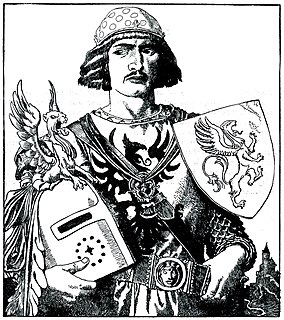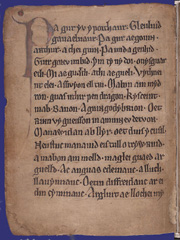Manawydan fab Llŷr is a figure of Welsh mythology, the son of Llŷr and the brother of Brân the Blessed and Brânwen. The first element in his name is cognate with the stem of the name of the Irish sea god Manannán mac Lir, and likely originated from the same Celtic deity as Manannán. Unlike Manannán, however, no surviving material connects him with the sea in any way except for his patronymic. Manawydan's most important appearances occur in the Second and Third Branches of the Mabinogi, but he is also referenced frequently in medieval poetry and the Welsh Triads.
Modron ("mother") is a figure in Welsh tradition, known as the mother of the hero Mabon ap Modron. Both characters may have derived from earlier divine figures, in her case the Gaulish goddess Matrona. She may have been a prototype for Morgan le Fay from the Arthurian legend.

Gawain, also known as Gawaine or Gauwaine, among various other forms and spellings, is King Arthur's nephew and a Knight of the Round Table in the Arthurian legend. Under the name Gwalchmei, he appears very early in the legend's development, being mentioned in some of the earliest Welsh Arthurian sources. As Gawain, he appears in Latin, French, English, Dutch, German and Italian literature, notably as the protagonist of the story of Sir Gawain and the Green Knight. Other tales of Gawain include Historia Regum Britanniae, Roman de Brut, De Ortu Waluuanii, Diu Crône, The Awntyrs off Arthure, L'âtre périlleux, Le Chevalier à l'épée, and The Weddynge of Syr Gawen and Dame Ragnell, as well as the works of Chrétien de Troyes and the prose cycle Lancelot-Grail.
The History of the Britons is a purported history of the indigenous British (Brittonic) people that was written around 828 and survives in numerous recensions that date from after the 11th century. The Historia Brittonum is commonly attributed to Nennius, as some recensions have a preface written in his name. Some experts have dismissed the Nennian preface as a late forgery, arguing that the work was actually an anonymous compilation.

Sir Bedivere is one of the earliest characters to be featured in the Matter of Britain, originally appearing in a number of early Welsh texts in which he is named as Bedwyr Bedrydant. In the later versions, he is described as being the Knight of the Round Table of King Arthur who serves as Arthur's marshal and eventually returns Excalibur to the Lady of the Lake. He is frequently associated with his brother Sir Lucan and his cousin Sir Griflet, as well as with Sir Kay.

In Arthurian legend, Sir Kay is King Arthur's foster brother and later seneschal, as well as one of the first Knights of the Round Table. In later literature he is known for his acid tongue and bullying, boorish behaviour, but in earlier accounts he was one of Arthur's premier warriors. Along with Bedivere, with whom he is frequently associated, Kay is one of the earliest characters associated with Arthur. Kay's father is called Ector in later literature, but the Welsh accounts name him as Cynyr Ceinfarfog.
The Thirteen Treasures of the Island of Britain are a series of items in late medieval Welsh tradition. Lists of the items appear in texts dating to the 15th and 16th centuries.
Peredur is the name of a number of men from the boundaries of history and legend in sub-Roman Britain. The Peredur who is most familiar to a modern audience is the character who made his entrance as a knight in the Arthurian world of Middle Welsh prose literature.
Morfran is a figure in Welsh mythology. Usually portrayed as a warrior under King Arthur, he is noted for the darkness of his skin and his hideousness. He appears in the narratives about the bard Taliesin and in the Welsh Triads, where he is often contrasted with the angelically handsome Sanddef.
Cath Palug, also Cath Paluc, Cath Balug, Cath Balwg, literally "Palug's cat", was a monstrous cat in Welsh legend, given birth in Gwynedd by the Henwen the pig of Cornwall; the cat was later to haunt the Isle of Anglesey, and said to have killed 180 warriors when Sir Kay went to hunt it on the island.
The Battle of Arfderydd was fought, according to the Annales Cambriae, in 573. The opposing armies are variously given in a number of Old Welsh sources, perhaps suggesting a number of allied armies were involved. The main adversaries appear to have been Gwenddoleu ap Ceidio and either the princely brothers, Peredur and Gwrgi, or King Riderch Hael of Strathclyde. Gwenddoleu was defeated and killed. His bard, Myrddin Wyllt, went mad and ran into the forest. He is probably the original of the Arthurian character, Merlin. The Welsh Triads refer to this battle as one of the "Three Futile Battles of the Island of Britain", along with the Battle of Camlann and the Battle of the Trees.
In the modern Gaelic languages, Lochlann signifies Scandinavia or, more specifically, Norway. As such it is cognate with the Welsh name for Scandinavia, Llychlyn. In both old Gaelic and old Welsh, such names literally mean "land of lakes" or "land of swamps".

King Arthur's family grew throughout the centuries with King Arthur's legend. Several of the legendary members of this mythical king's family became leading characters of mythical tales in their own right.
Gwrgi, brother of Peredur, is a figure of medieval British legend.
Glewlwyd Gafaelfawr; "Brave Grey Mighty Grasp," is a hero, warrior and porter in tradition and Arthurian mythology, in which he appears as a knight in Arthur's retinue and chief gatekeeper of his court. He is one of the earliest characters to be associated with Arthur and appears in a number of texts, including Culhwch ac Olwen, Geraint fab Erbin, Iarlles y Ffynnon, Pa Gur yv y Porthur and the Welsh Triads.












